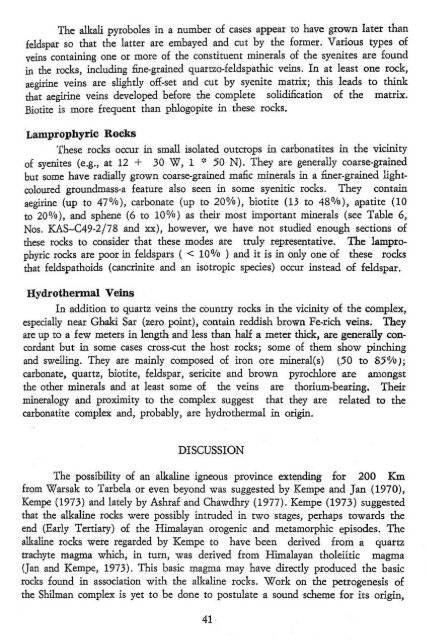Petrography Of The Loe Shilman Carbonatite Complex Khyber Agency
Petrography Of The Loe Shilman Carbonatite Complex Khyber Agency
Petrography Of The Loe Shilman Carbonatite Complex Khyber Agency
Create successful ePaper yourself
Turn your PDF publications into a flip-book with our unique Google optimized e-Paper software.
<strong>The</strong> alkali pyroboles in a number of cases appear to have grown Iater than<br />
feldspar so that the latter are embayed and cut by the former. Various types of<br />
veins containing one or more of the constituent minerals of the syenites are found<br />
in the rocks, including fine-grained quartzo-feldspathic veins. In at least one rock,<br />
aegirine veins are slightly off-set and cut by syenite matrix; this leads to think<br />
that aegirine veins developed before the complete solidification of the matrix.<br />
Biotite is more frequent than phlogopite in these rocks.<br />
Lamprophyfic Rocks<br />
<strong>The</strong>se rocks occur in small isolated outcrops in carbonatites in the vicinity<br />
of syenites (e,g., at 12 + 30 W, 1 'I' 50 N). <strong>The</strong>y are generally coarse-grained<br />
but some have radially grown coarse-grained mafic minerals in a finer-grained lightcoloured<br />
groundmass-a feature also seen in some syenitic rocks. <strong>The</strong>y contain<br />
aegirine (up to 47%), carbonate (up to 20%), biotite (13 to 4g0/o), apatite (10<br />
to 20•‹:0), and sphene (6 to 10%) as their most important minerals (see Table 6,<br />
Nos. KAS-C49-2/78 and xx), however, we have not studied enough sections of<br />
these rocks to consider that these modes are truly representative. <strong>The</strong> lamptophyric<br />
rocks are poor in feldspars ( < 1O0h ) and it is in only one of these rocks<br />
that feldspathoids (cancrinite and an isotropic species) occur instead of feldspar.<br />
Hydro thermal Veins<br />
In addition to quartz veins the country rocks in the vicinity of the complex,<br />
especially near Ghaki Sar (zero point), contain reddish brown Fe-rich veins. <strong>The</strong>y<br />
are up to a few meters in length and less than half a meter thick, are generally concordant<br />
but in some cases crosscut the host rocks; some of them show pinching<br />
and swelling. <strong>The</strong>y are mainly composed of iron ore rnineral(s) (50 to 85%);<br />
carbonate, quartz, biotite, feldspar, sericite and brown pyrochlore are amongst<br />
the other minerals and at least some of the veins are thorium-bearing. <strong>The</strong>ir<br />
mineralogy and proximity to the complex suggest that they are related to the<br />
carbonatite complex and, probably, are hydrothermal in origin.<br />
DISCUSSION<br />
<strong>The</strong> possibility of an alkaline igneous province extending for 200 Km<br />
from Warsak to Tarbela or even beyond was suggested by Kempe and Jan (1970),<br />
Kempe (1973) and lately by Ashraf and Chawdhry (1977). Kempe (1973) suggested<br />
that the alkaline rocks were possibly intruded in two stages, perhaps towards the<br />
end (Early Tertiary) of the Himalayan orogenic and metamorphic episodes. <strong>The</strong><br />
akaline rocks were regarded by Kempe to have been derived from a quartz<br />
trachyte magma which, in turn, was derived from Himalayan tholeiitic magma<br />
(Jan and Kempe, 1973). This basic magma may have directly produced the basic<br />
rocks found in association with the alkaline rocks. Work on the petrogenesis of<br />
the <strong>Shilman</strong> complex is yet to be done to postulate a sound scheme for its origin,

















